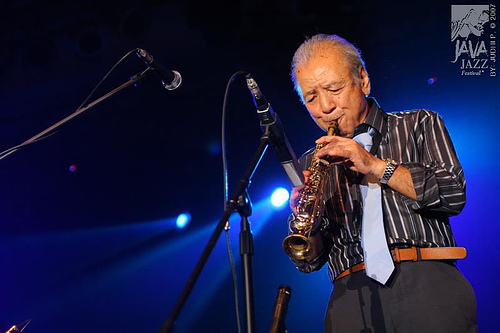
Jazz
爵士音乐
A few years ago a friend took me to Samurai, a jazz bar in Tokyo’s Shinjuku district whose owner, a haiku poet, stood behind the bar surrounded by thousands of maneki neko—smiling, waving cat figurines. He had a primitive video camera trained on the sleeve of the record album he was playing, and he projected that image onto the wall. Samurai had its own quirks, but it wasn’t an unusual type of place: The jazz bar and its cousin, the jazz kissaten, a coffee shop focused on jazz, are shrines to recorded music, dreamlands for high-fidelity obsessives. They offer a kind of jazz experience based on pure appreciation of the act of listening.
几年前一个朋友带我去了 Samurai——一家位于东京新宿区的爵士酒吧,酒吧老板是一位俳句诗人。他站在吧台后面,周围是数以千计的招财猫——微笑着,挥动手臂。他用一个老式的放映机播放胶片,把影像投射到墙上。这家店有自己的风格,但在日本并非少见,比如爵士吧和爵士咖啡馆——专注于爵士乐的咖啡店,热衷于播放音乐磁带,以成为高保真乐迷们的梦想天堂,通过纯粹的倾听来享受爵士乐所带来的快乐。
In Tokyo I track down James Catchpole, an American expat and jazz expert who goes by the very Japanese-sounding nickname of Mr. OK Jazz, to understand what’s happening right now to Japanese jazz culture. "When these kissa started back in the '50s and '60s, Tokyo apartments were too small to play music in," Catchpole says. "Imported records were really expensive. Jazz kissa were the only places in the city where fans could listen to the music they loved." The coffee shops became hideaways where jazz lovers could relax, hear new records and learn about trends like free jazz from others who knew the music well. In the ’60s, when jazz was allied with Japanese university counterculture, jazz kissa became organizing centers for the student protests that rocked Japan. But of course Japanese people no longer need to visit a bar or café to listen to recorded jazz. "Are jazz kissa going to survive?" I ask Catchpole.
在东京,为了理解现在日本的爵士文化,我找到了凯奇波尔。他是一位美国移民和爵士乐专家,周围追捧他的日本人送给他一个绰号为ok爵士先生。“当这种爵士咖啡馆在5、60年代刚刚兴起时,东京的房子还太小,所以不足以播放音乐。”他说道,“并且进口的磁碟非常昂贵。所以城市里的乐迷们只有在这种咖啡馆里才能听到自己喜欢的音乐。”这样的咖啡店成为爵士迷们放松心情的桃花源,来到这里欣赏新的乐曲,从深谙爵士乐的人那里了解像自由爵士乐一类的流行风尚。在60年代,当爵士乐与日本大学的反主流文化结盟后,爵士咖啡吧成为学生们组织抗议的根据地。但当然,日本人现在不再需要去酒吧或咖啡馆来欣赏磁带爵士乐了。我问凯奇波尔“那么爵士咖啡吧还会继续存在吗?”
"Go to Kissa Sakaiki and find out," he says.
“去sakaiki咖啡吧找答案吧”他说。
Tokyo's tiny cafés, bars and restaurants are notoriously difficult to locate. Even with a GPS-equipped iPhone, a print atlas and the help of police guarding a nearby embassy, I spend half an hour wandering the back streets of Yotsuya, a residential Tokyo neighborhood not far from Shinjuku, before I turn the corner and see the discreet sign for Sakaiki.
东京的微型咖啡店、酒吧和餐馆特别难找。即使用GPS定位功能的iphone,一张地图册,并且在附近大使馆保安的帮助下,我还是在临近新宿地区的yotsuya居民区的小街里转了半个小时,转过一个街角才发现隐秘的sakaiki店铺标志。
What makes places like Sakaiki or the Bob Dylan bar survive and sometimes prosper is the fragmentation of bar, café and restaurant culture in Tokyo. An eight-seat pub stands out in New York as supremely small, yet in Tokyo there are at least three nightlife neighborhoods consisting almost entirely of eight-seat bars. You don’t need many fans of whatever it is you’re into to support a bar, café or restaurant devoted to that obsession.
像sakaiki或者鲍勃迪伦酒吧做之所以能够生存甚至繁荣起来,主要应归因于东京破碎的酒吧、咖啡馆以及小餐馆文化。在纽约一个八个座位的酒吧会显得极其狭小,而在东京至少三个夜生活地区完全都是由这类型酒吧组成。无论如何,你并不需要太多乐迷来支撑这样专门的酒吧、咖啡厅或者餐馆。
When I enter Sakaiki, owner Fumito Fukuchi, wearing a gray newsboy cap turned backward, waves me to the bar. Seated next to me is a Swedish free-jazz clarinetist speaking English to a group of Japanese. I tell Fukuchi that Mr. OK Jazz sent me. He nods a welcome and serves me a cold beer. The place is small, warm and gently lit, with a green-shaded banker’s lamp shining on the album cover of the record he’s playing. I ask Fukuchi how he came to run Sakaiki.
当我进入sakaiki,带着灰色报童帽的老板fukuchi便向我招手,带我进去。坐在我旁边的是一个瑞典的自由爵士乐吹奏者,正在操着英语与一群日本人交谈。我告诉fukuchi是ok爵士先生叫我来的。他点头表示欢迎,给了我一杯冰镇啤酒。这地方很小,但很暖和。一盏墨绿色的银行家台灯在唱片封面上闪着柔和的光。我问fukuchi为什么要经营这这家sakaiki。
"I was a salaryman working in IT until 2007," he tells me, as he cleans, inspects and preps the next record in his rotation. "Jazz kissa were my hobby," he says, leading me to a coffee table covered in matchboxes from the jazz kissa of Tokyo. He picks up a matchbook that reads, "Eagle." "This is the first one I ever visited. It’s right here in Yotsuya. I read the owner’s book about jazz when I was a teenager in Hokkaido. As soon as I came to Tokyo, I headed for Eagle." Many of the matchbooks Fukuchi flips through are from jazz kissa that have long been closed. And all the other jazz kissa he knows of in Tokyo, he tells me, are run by men a decade or two older than he is—and he's 41.
“直到2007年之前我都是一个在IT行业工作的工薪族,”他一边清理、检查并且为下次循环记录做准备,一边和我说。“爵士咖啡馆是我的爱好”他边说边领着我到了放满了来自于东京爵士咖啡馆火柴盒的茶几边。他拾起一个火柴盒并读到“Eagle,这是我曾经去过的第一个爵士咖啡馆,它就在这儿,四谷。当我在北海道,还是个孩子的时候,我读了那间咖啡馆主人有关爵士的书籍。我一到东京,就直奔Eagle而去。”Fukuchi收集的许多火柴盒都来自于已经关闭许久了的爵士咖啡馆。他告诉我说,他所知道的在东京的所有其他咖啡馆都由比他大十几二十几的人在运营着——而他已经41岁了。
The obvious question is why go out of your way to hear recorded music with other people when technology has made it easy to listen alone? The answer comes to me as I look around the room at the people brought together by the music Sakaiki has collected: International jazz musicians, local workers and jazz fans from all over the city are here because they appreciate the act of listening to a record together. It’s a pleasure that anyone who grew up before the era of the Walkman and iTunes can appreciate. What’s uncertain is whether the next generation will cherish the same experience.
最显而易见的问题是为什么当现在技术已经使你很容易能找到想听的音乐的时候,你还需要和别人一块去听录制音乐?当我环顾房间,看见因为Sakaiki收集的音乐而聚集在一起的是什么类型的人时,答案就不言自明了:是国际爵士音乐家,当地的工人以及来自于这个城市各个地方的爵士粉丝们,他们来到这里是因为他们欣赏这种聚在一起听录制音乐的行为。很高兴在这个拥有Walkman和iTunes的时代之前长大的人能够欣赏这样的行为。但我并不确定我们的下一代是否将会珍惜这样的经历。
n. 产品,农作物
vt. 生产,提出,引起,












